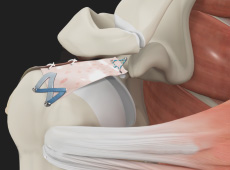
What is Arthroscopic Superior Capsular Reconstruction (SCR)?
Superior Capsular Reconstruction is a surgical procedure to repair massive, irreparable rotator cuff tears. The surgery involves reconstruction of the superior capsule of the shoulder joint using an autograft (tissue from the same person) or an allograft (tissue from a donor).
Anatomy
The upper part of the capsular lining of your shoulder joint is the superior capsule. A rotator cuff is a group of 4 muscles in the shoulder joint including the supraspinatus, infraspinatus, teres minor, and subscapularis. These muscles originate in the scapula and attach to the head of the humerus through tendons. The rotator cuff forms a sleeve around the humeral head and glenoid cavity, providing stability to the shoulder joint while enabling a wide range of movements.
Indications for Arthroscopic SCR
Arthroscopic SCR is indicated for massive, irreparable superior rotator cuff tears that cause significant shoulder dysfunction. Reconstructing the superior capsule will help restore stability to the shoulder and minimize dysfunction.
Arthroscopic SCR Procedure
Surgery is performed through arthroscopy. An arthroscope is a small, fiber-optic instrument consisting of a lens, light source, and video camera. The camera projects images of the inside of the joint onto a large monitor, allowing your surgeon to look for any damage, assess the type of injury and repair it.
The surgical procedure involves the following steps:
- You may be given general anesthesia and regional anesthesia.
- You will be plaed in the beach hair position
- Small incisions are made on the skin around the shoulder joint.
- An arthroscope and small specialized surgical instruments are inserted.
- The shoulder joint and rotator cuff are visualised and debrided.
- The bones of the shoulder joint are prepared for graft placement.
- Suture anchors are placed.
- The graft is passed and secured down to bone with sutures.
- Any surrounding rotator cuff tissue may be repaired to the graft.
- A final assessment of the shoulder is performed, and the incision is closed.
Recovery after Surgery
Your doctor will prescribe pain medicines as needed. Your shoulder is supported with a sling for about 6 weeks. Your physiotherapist will teach specific physical exercises to help you recover sooner.
Risks and Complications
As with any surgery, there are risks and complications that may occur. Those related to superior capsular reconstruction may include:
- Anesthetic complications
- Infection
- Nerve damage
- Stiffness
- Tendon re-tear
Related Topics
- Proximal Biceps Tenodesis
- Intraarticular Shoulder Injection
- Arthroscopic Acromioplasty
- Shoulder Joint Replacement
- Reverse Shoulder Replacement
- Rotator Cuff Repair
- SLAP Repair
- Arthroscopic Bankart Repair
- Arthroscopic Frozen Shoulder Release
- Latarjet Procedure
- Shoulder Arthroscopy
- Distal Clavicle Excision
- Pectoralis Major Tears/Repairs
- ORIF of the Clavicle Fractures
- Arthroscopic Superior Capsular Reconstruction (SCR)
- Subacromial Decompression
- Shoulder Resurfacing
- Acromioclavicular (AC) Joint Reconstruction





